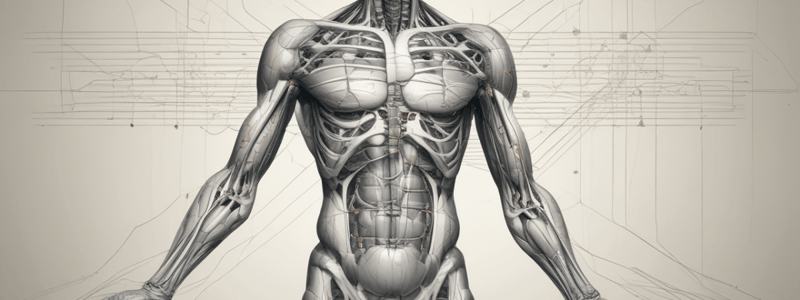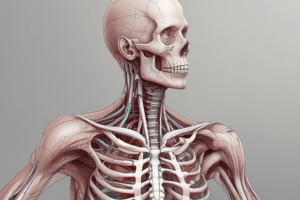Podcast
Questions and Answers
Which artery supplies blood to the forehead and upper eyelids?
Which artery supplies blood to the forehead and upper eyelids?
- frontal artery (correct)
- greater auricular artery
- facial artery
- external jugular artery
What does the fifth cranial nerve control?
What does the fifth cranial nerve control?
- chewing (correct)
- swallowing
- smiling
- blinking
Which bone forms the forehead?
Which bone forms the forehead?
- frontal bone (correct)
- parietal bone
- facial bone
- temporal bone
What is the function of the flexor muscle?
What is the function of the flexor muscle?
Which vein carries blood returning to the heart from the head, face, and neck?
Which vein carries blood returning to the heart from the head, face, and neck?
Which nerve affects the face, ears, and neck?
Which nerve affects the face, ears, and neck?
What is another term for general circulation?
What is another term for general circulation?
What does the facial artery supply blood to?
What does the facial artery supply blood to?
Which of the following bones forms the upper jaw?
Which of the following bones forms the upper jaw?
Which of the following bones are not paired in the facial skeleton?
Which of the following bones are not paired in the facial skeleton?
How many bones make up the facial skeleton?
How many bones make up the facial skeleton?
Which of the following bones are involved in the formation of the eye socket?
Which of the following bones are involved in the formation of the eye socket?
What is the function of the turbinal bones?
What is the function of the turbinal bones?
Which portion of the epicranius does the frontalis muscle correspond to?
Which portion of the epicranius does the frontalis muscle correspond to?
What is the frontalis muscle?
What is the frontalis muscle?
Which of the following is a characteristic of the frontalis muscle?
Which of the following is a characteristic of the frontalis muscle?
What is the anatomical region that the frontalis muscle belongs to?
What is the anatomical region that the frontalis muscle belongs to?
Which term is associated with the frontalis muscle?
Which term is associated with the frontalis muscle?
What is the primary function of glands in the body?
What is the primary function of glands in the body?
What is a characteristic of glands in the body?
What is a characteristic of glands in the body?
What do glands have the ability to do?
What do glands have the ability to do?
What is the result of glands converting elements from the blood into new compounds?
What is the result of glands converting elements from the blood into new compounds?
What is the role of glands in the body?
What is the role of glands in the body?
Where is the great occipital nerve located?
Where is the great occipital nerve located?
What is affected by the great occipital nerve?
What is affected by the great occipital nerve?
Which part of the body is innervated by the great occipital nerve?
Which part of the body is innervated by the great occipital nerve?
What is the function of the great occipital nerve?
What is the function of the great occipital nerve?
What is the anatomical location of the great occipital nerve?
What is the anatomical location of the great occipital nerve?
Flashcards are hidden until you start studying
Study Notes
Blood Vessels
- The external jugular vein is located at the side of the neck and carries blood returning to the heart from the head, face, and neck.
- The facial artery supplies blood to the lower region of the face, mouth, and nose.
- The frontal artery supplies blood to the forehead and upper eyelids.
Bones
- The facial skeleton consists of two nasal bones, two lacrimal bones, two zygomatic bones, two maxillae, the mandible, two turbinal bones, two palatine bones, and the vomer.
- The frontal bone forms the forehead.
Muscles
- The frontalis is the anterior or front portion of the epicranius and is a muscle of the scalp.
- The flexor is an extensor muscle of the wrist involved in flexing the wrist.
Nervous System
- The fifth cranial nerve is the chief sensory nerve of the face and controls chewing.
- The greater auricular nerve is located at the sides of the neck and affects the face, ears, and neck.
- The greater occipital nerve is located at the back of the head and affects the scalp.
Circulatory System
- The heart is a muscular, cone-shaped organ that keeps blood moving through the circulatory system.
- General circulation refers to systemic circulation.
Other
- Glands are specialized organs that remove certain elements from the blood and convert them into new compounds.
Blood Vessels
- External jugular vein: located at the side of the neck, carries blood returning to the heart from the head, face, and neck
- Facial artery: supplies blood to the lower region of the face, mouth, and nose
- Frontal artery: supplies blood to the forehead and upper eyelids
Bones
- Frontal bone: forms the forehead
- Facial skeleton: consists of two nasal bones, two lacrimal bones, two zygomatic bones, two maxillae, the mandible, two turbinal bones, two palatine bones, and the vomer
Muscles
- Frontalis: muscle of the scalp, located at the anterior or front portion of the epicranius
- Flexor: extensor muscle of the wrist involved in flexing the wrist
Nerves
- Fifth cranial nerve: chief sensory nerve of the face, controls chewing
- Greater auricular nerve: located at the sides of the neck, affects the face, ears, and neck
- Greater occipital nerve: located at the back of the head, affects the scalp
Circulatory System
- Heart: muscular, cone-shaped organ that keeps blood moving through the circulatory system
- General circulation: see systemic circulation
Organs
- Glands: specialized organs that remove certain elements from the blood and convert them into new compounds
Glossary of Anatomical Terms
Blood Vessels
- External jugular vein: located at the side of the neck, carries blood returning to the heart from the head, face, and neck
- Facial artery: supplies blood to the lower region of the face, mouth, and nose
- Frontal artery: supplies blood to the forehead and upper eyelids
Muscles
- Flexor: extensor muscle of the wrist involved in flexing the wrist
- Frontalis: muscle of the scalp, located at the anterior or front portion of the epicranius
Nervous System
- Fifth cranial nerve: chief sensory nerve of the face, controls chewing
- Greater auricular nerve: located at the sides of the neck, affecting the face, ears, and neck
- Greater occipital nerve: located at the back of the head, affecting the scalp
Bones
- Facial skeleton: composed of two nasal bones, two lacrimal bones, two zygomatic bones, two maxillae, the mandible, two turbinal bones, two palatine bones, and the vomer
- Frontal bone: forms the forehead
Organs
- Glands: specialized organs that remove certain elements from the blood and convert them into new compounds
- Heart: muscular, cone-shaped organ that keeps blood moving through the circulatory system
Glossary of Anatomical Terms
Head and Neck
- The external jugular vein is located at the side of the neck and carries blood returning to the heart from the head, face, and neck.
- The facial artery supplies blood to the lower region of the face, mouth, and nose.
- The frontal artery supplies blood to the forehead and upper eyelids.
Facial Skeleton
- The facial skeleton consists of two nasal bones, two lacrimal bones, two zygomatic bones, two maxillae, the mandible, two turbinal bones, two palatine bones, and the vomer.
Muscles
- The frontalis is the anterior or front portion of the epicranius and is a muscle of the scalp.
- The flexor is an extensor muscle of the wrist involved in flexing the wrist.
Nerves
- The fifth cranial nerve is the chief sensory nerve of the face and controls chewing.
- The greater auricular nerve is located at the sides of the neck and affects the face, ears, and neck.
- The greater occipital nerve is located at the back of the head and affects the scalp.
Circulatory System
- The heart is a muscular, cone-shaped organ that keeps blood moving through the circulatory system.
- The general circulation refers to the systemic circulation.
Other
- Glands are specialized organs that remove certain elements from the blood and convert them into new compounds, varying in size and function.
Blood Vessels
- External jugular vein: carries blood from the head, face, and neck back to the heart.
- Facial artery: supplies blood to the lower region of the face, mouth, and nose.
- Frontal artery: supplies blood to the forehead and upper eyelids.
Bones
- Facial skeleton: consists of two nasal bones, two lacrimal bones, two zygomatic bones, two maxillae, the mandible, two turbinal bones, two palatine bones, and the vomer.
- Frontal bone: forms the forehead.
Muscles
- Frontalis: muscle of the scalp, located at the anterior or front portion of the epicranius.
- Flexor: extensor muscle of the wrist involved in flexing the wrist.
Nerves
- Fifth cranial nerve: chief sensory nerve of the face, controls chewing.
- Greater auricular nerve: affects the face, ears, and neck, located at the sides of the neck.
- Greater occipital nerve: affects the scalp, located at the back of the head.
Organs
- Heart: a muscular, cone-shaped organ that keeps blood moving through the circulatory system.
- Glands: specialized organs that remove certain elements from the blood and convert them into new compounds, varying in size and function.
Circulation
- General circulation: also known as systemic circulation.
Studying That Suits You
Use AI to generate personalized quizzes and flashcards to suit your learning preferences.




